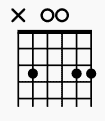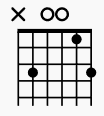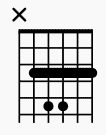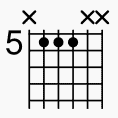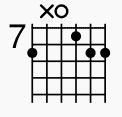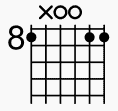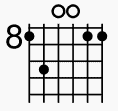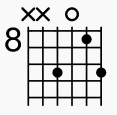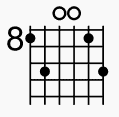Suspended chords have a delicious dissonance about them. They instantly turn a basic chord progression into something a little more interesting. Whether you use CSus2 in place of C or Cm, or resolve to either of those, it’s an easy way to add some complexity to your songs.
Best of all, CSus2 is actually an easy chord to play, depending on which voicing you choose. And even with the harder ones, that’s nothing a bit of practice can’t fix. Let’s get into how to play the CSus2 guitar chord, and what CSus2 actually is.
What is a Suspended Chord?
Suspended chords are simply triads where the 3rd interval in a major or minor chord has been replaced with the 2nd or 4th interval.
Let’s take a look at the C chord, like all major triads, it’s constructed from the 1st, 3rd, and 5th intervals of the relevant major scale:
C-E-G
The C major scale has no sharps or flats according to the circle of fifths:
C, D, E, F, G, A, B
1 2 3 4 5 6 7
In terms of C minor, I’m going to use this C major scale as that shows the flattened 3rd interval perfectly. That’s what a minor triad is: 1, 3♭, 5
C-E♭-G
As you may have guessed, CSus2 replaces the 3rd interval with the 2nd interval:
C-D-G
You can now clearly see that there is dissonance. Because of the G, the chord still sounds good. If it was just the C and the D, most of us would find it a horrible sound. This dissonance creates tension, which is why resolving up to C or Cm works so well. It provides relief.
How to Play the CSus2 Guitar Chord
Here are the various ways to play CSus2. You can start off with the easy ones to get you going. But don’t be afraid to try the harder ones. Work on them regularly, and you’ll see, soon they will become automatic.
CSus2 Version 1
As with the open C chord, you skip the low E string. It’s easy in that you don’t have any other strings to mute. If you want to skip the open string when you pluck the strings, you can do that, since all the fretted notes make up the CSus2 chord.
- Index finger: 5th string, 3rd fret (C)
- Middle or ring finger: 2nd string, 3rd fret (D)
- Ring or pinky finger: 1st string, 3rd fret (G)
The open strings give you G (3rd string) and D (4th string).
CSus2 Version 2
While this voicing will be roughly the same pitch as the previous one, it will sound slightly different. You’ll just need to play all these voicings and find which sound best to you.
- Index finger: 2nd string, 1st fret (C)
- Ring finger: 5th string, 3rd fret (C)
- Pinky finger: 1st string, 3rd fret (G)
Again, the open strings give you G and D.
CSus2 Version 3
This version is a bit of a finger twister, but play it enough and muscle memory will kick in. It’s like the barre chord, but with an open string in the middle, which means you can’t barre the whole fret.
- Index finger: 5th string, 3rd fret (C)
- Middle finger: Barre strings 1 and 2, 3rd fret (G, D)
- Ring or pinky finger: 4th string, 5th fret (G)
The open string gives you a G.
CSus2 Version 4
This is purely a matter of preference. This voicing is almost identical to the previous one except for the open string.
- Index finger: 5th string, 3rd fret (C)
- Middle finger: Barre strings 1 and 2, 1st fret (G, D)
- Ring or pinky finger: 3rd string, 5th fret (C)
The open string gives you a D.
CSus2 Version 5
If you’re new to barre chords, this will take some practice. Make sure you practice playing this version regularly to build up the strength in your hands and get your wrists used to this position. You want all the strings to ring out clearly.
- Index finger: Barre strings 1-5 in the 3rd fret (1st-G, 2nd-D, 5th-C)
- Ring finger: 4th string, 5th fret (G)
- Pinky finger: 3rd string, 5th fret (C)
CSus2 Version 6
This is a higher voicing that’s fairly simple to play and works well over one of the lower voicings. You’ll need to angle your hand if you intend to strum this chord so that you can mute the surrounding strings. This voicing, however, is better suited to plucking or picking the strings as it’s not a very full sounding chord.
- Index finger: 5th string, 5th fret (D)
- Middle finger: 4th string, 5th fret (G)
- Ring finger: 3rd string, 5th fret (C)
Or:
Barre the chord using your index finger, but be careful not to play the other strings, as those notes aren’t in the CSus2 chord.
CSus2 Version 7
For a slightly fuller sound, try this voicing. It’s a bit of a stretch, so it can be a bit tricky if you’re new to barre chords, but you should get the hang of it soon enough. It actually makes it a little easier since you don’t have to rely on barring all the strings with only one finger. Plus, it adds some higher notes for a beautiful sound.
- Index finger: Barre strings 3-5 in the 5th fret (C, G, D)
- Pinky finger: Barre strings 1 and 2 in the 8th fret (C, G)
CSus2 Version 8
For a truly full sounding chord, this voicing does well. It’s an advanced shape, however, and unfortunately, only really possible for those with bigger hands to play. But, I would have been remiss if I left it out. Work your way up to this one and enjoy what larger hands enable you to do.
- Index finger: Barre strings 3-5 in the 5th fret (C, G, D)
- Ring finger or thumb: 6th string, 8th fret (C)
- Pinky finger: Barre strings 1 and 2 in the 8th fret (C, G)
CSus2 Version 9
This is quite a high-pitched voicing and sounds rather delicate. You’ll need to angle your hand to let the strings ring out clearly, but also to mute that 5th string if you’re going to be strumming. With some practice though, you’ll find that if you pick/strum the 6th string first and then the rest of the strings, you may have no trouble eventually automatically skipping the 5th string.
- Index finger: 3rd string, 7th fret (D)
- Middle finger: 6th string, 8th fret (C)
- Ring finger: 2nd string, 8th fret (G)
- Pinky finger: 1st string,8th fret (C)
CSus2 Version 10
A simple, but beautiful voicing.
- Index finger: 6th string, 8th fret (C)
- Ring finger: 2nd string, 8th fret (G)
- Ring finger: 1st string, 8th fret (C)
Alternatively, use your middle finger to barre the 1st and 2nd string.
The open strings give you G and D.
CSus2 Version 11
This version is almost identical to the previous voicing, but fretting the 5th string in the 10th fret eliminates the need to avoid that string.
- Index finger: 6th string, 8th fret (C)
- Middle finger: Barre the 1st and 2nd string in the 8th fret (G, C)
- Ring or pinky finger: 5th string, 10th fret (G)
The open strings give you G and D.
CSus2 Version 12
This combination of notes give this voicing a unique flavor, but despite the lower G, this won’t be a full-sounding chord.
- Index finger: 2nd string, 8th fret (G)
- Ring finger: 1st string, 10th fret (D)
- Pinky finger: 4th string, 10th fret (C)
The open string gives you a G.
CSus2 Version 13
For a fuller voicing, this voicing provides an option. It’s a bit advanced, and it can take some angling to get it right, but if you really enjoy it, practice playing it regularly.
- Index finger: 6th string, 8th fret (C)
- Middle finger: 2nd string, 8th fret (G)
- Ring finger: 4th string, 10th fret (C)
- Pinky finger: 1st string, 10th fret (D)
The open strings give you a G and a D.
CSus2 Version 14
For a very high-pitched voicing, this version will do. It’s still easy to reach this far down the neck, even on non-cutaway guitar shapes. Angle your index finger just right to mute that 2nd string.
- Index finger: Barre strings 1-6 (D, C, D, G)
- Middle finger: 3rd string, 12th fret (G)
When to Use CSus2
Because of the tone of CSus2, you can use it in a progression with other suspended chords for a more haunting quality to your song.
CSus2 also resolves up to C or Cm very well. Use it before either of those chords as a passing chord. You can also alternate between CSus2 and C or Cm if you want to play the intro, verse, or phrase in just C, but find that a bit boring. Using the CSus2 in this way will give you enough variation while keeping most of the notes the same.
If you’re composing a song fraught with tension or melancholy, you can choose to keep that mood for even the end of the song. Instead of resolving the song at the end, just play CSus2.
Conclusion
The CSus2 guitar chord is beautiful, and yet, in most cases simple to play. You can play it all over the neck, so you can adapt your playing as necessary, or add some sparkle to a song by playing higher voicings over lower ones.
Start with the easy versions and then work your way up to the harder ones for practice. Just remember, that one or two of those shapes are nigh impossible for those of us with small hands. But with all the options available, there’s no reason to be sad about that fact. Choose the versions that sound the nicest to you and start putting them in your songs.
Happy jamming!

Cheanné Lombard lives in the home of one of the new Seven World Wonders, Cape Town, South Africa. She can’t go a day without listening to or making music.
Her love of music started when her grandparents gave her a guitar. It was a smaller version of the full-sized guitars fit for her little hands. Later came a keyboard and a few years after that, a beautiful dreadnought guitar and a violin too. While she is self-taught when it comes to the guitar, she had piano lessons as a child and is now taking violin lessons as an adult.
She has been playing guitar for over 15 years and enjoys a good jam session with her husband, also an avid guitarist. In fact, the way he played those jazzy, bluesy numbers that kindled the fire in her punk rock heart. Now she explores a variety of genres and plays in the church worship group too and with whoever else is up for a jam session.
